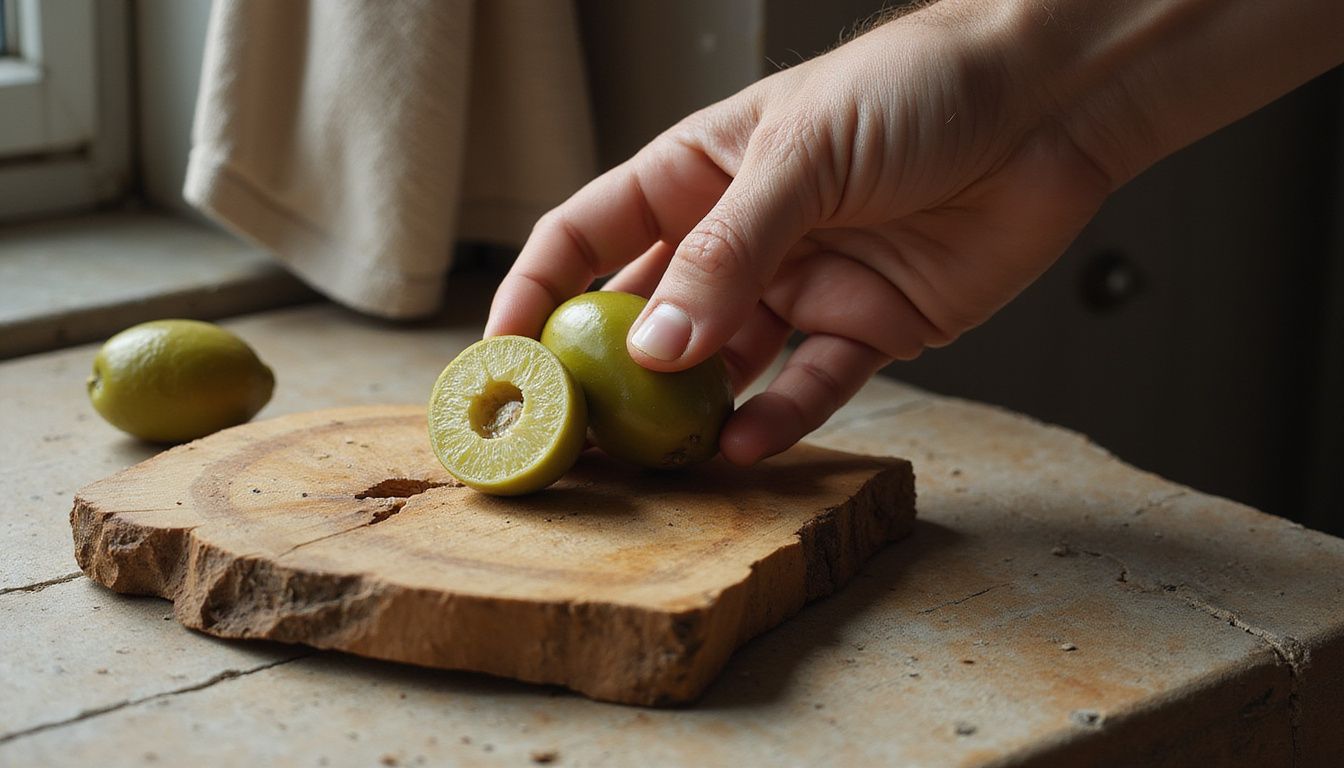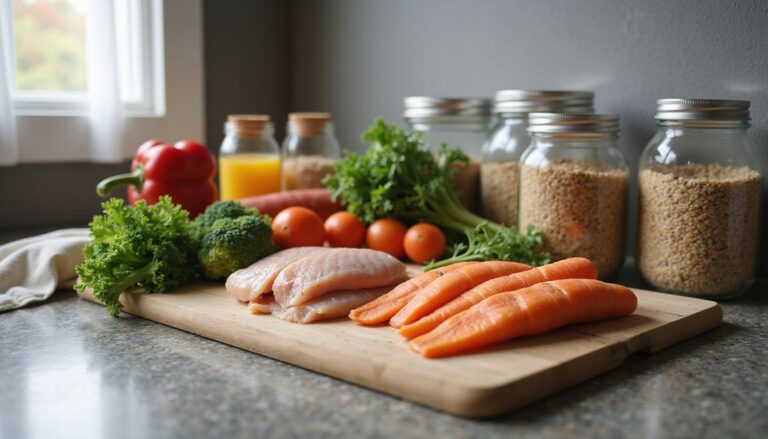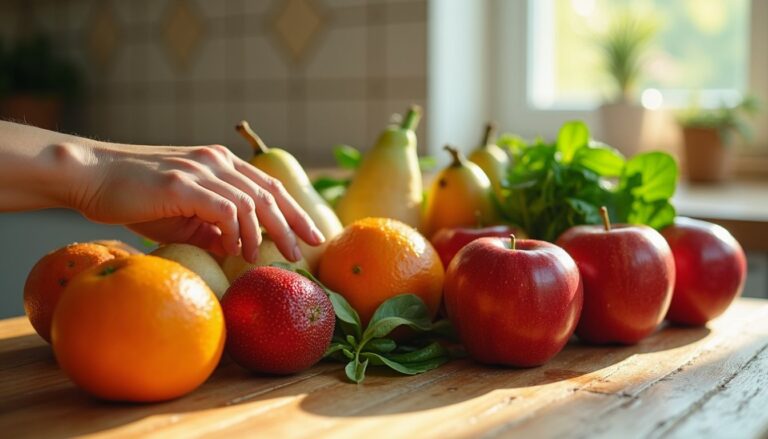Sodium Rich Fruits: Top Picks For High Sodium Content
Our Nutrition Assistant AI Suite will transform your body. You will lose fat, get toned, and build muscle. Gain confidence and optimal health.
Trying to manage sodium in your diet can feel tricky. Most fruits are low sodium, yet a few are higher in sodium than you might expect. Knowing the sodium content helps you choose foods that fit your plan and avoid foods high in sodium when needed.
This guide compares sodium levels in fruits, shows how they stack up against salty convenience foods, and explains how to use the nutrition facts label. You will see which fruits are naturally higher, plus easy ways to fit them into a healthy diet.
Read on to find the fruit choices that might surprise you with their salt and sodium content.
Key Takeaways
- Green olives deliver about 233.4 mg of sodium in five olives, far more than fresh fruits like bananas or apples, which have under 5 mg per cup.
- The World Health Organization advises adults to keep sodium intake under 2,000 mg per day, while most fresh fruits count as low sodium with less than 5 mg per serving.
- Dried sweetened mango can contain around 162 mg per 100 grams. In contrast, some processed foods can climb to 38,000 mg per 100 grams because of salt added during processing.
- Passion fruit provides roughly 66.1 mg per cup, placing it among the higher sodium fruit choices on standard food composition lists.
- Always check the nutrition facts label. Canned, cured, or seasoned products often contain much more sodium per serving than their fresh versions.

Understanding Sodium in Fruits

Sodium is a mineral and an electrolyte. Electrolytes help your body manage fluids and send nerve signals. Fruits and vegetables contain sodium in small amounts, which is helpful if you want steady intake without overload.
What is sodium and why does it matter?
You get sodium from a wide variety of foods, including vegetables and fruits. This nutrient supports fluid balance, muscle function, and nerve signaling. Labels list sodium in milligrams per serving or per 100 grams.
Health agencies note that most adults should limit daily sodium. The World Health Organization sets a target below 2,000 mg per day. In the United States, the Daily Value used on labels equals 2,300 mg per day. Both targets aim to reduce heart and blood pressure risks.
I started scanning labels during weekly shopping and found big differences. Canned vegetables and tomato sauce often carried far more sodium than fresh produce or whole grain bread.
Why is sodium important in a healthy diet?
Sodium helps your body hold the right amount of water. Muscles need it to contract. Nerves use it to pass signals between the brain and your body.
Too little sodium can cause fatigue or muscle cramps. Too much can raise blood pressure. Most adults do best staying under 2,000 to 2,300 milligrams per day, based on global and U.S. guidance. Choosing foods lower in sodium supports heart health and lowers risk for hypertension.
During a low-sodium trial, I felt sluggish. Adding a small amount from natural foods, like olives with meals, brought my energy back without turning to salty snacks.
How does sodium in natural foods compare to processed foods?
Fresh fruits are usually very low in sodium. Highly processed foods, especially those with salt added, can be extremely high. Here is a quick comparison:
- Fresh or frozen fruits: about 0 to 5 mg per 100 grams.
- Table salt, baking soda, baking powder: up to 38,000 mg per 100 grams.
- Bouillon cubes and powdered broths: around 20,000 mg per 100 grams.
- Salty snacks like pretzels or cheese puffs: often up to 1,500 mg per 100 grams.
- Fresh beef: about 48 mg per 100 grams. Canned corned beef: around 950 mg per 100 grams.
Meals made with fresh produce usually taste clean and need less seasoning. Packaged soups and boxed mixes often taste much saltier. Check the nutrition facts label to find lower-sodium foods that fit your goals.
Top Sodium Rich Fruits
A few fruits are naturally higher in sodium. Others pick up sodium during curing or brining. Use this section to decide what fits your sodium intake plan.
What makes green olives high in sodium?
Green olives are high in sodium because they are preserved in brine, a saltwater solution. A serving of five green olives, pickled or canned, contains about 233.4 mg of sodium, roughly 10 percent of the Daily Value.
Even a single super colossal olive can supply 110.3 mg, and three canned ripe olives provide around 88.2 mg. Brining keeps olives safe to eat and builds their bold, salty taste, but it also pushes sodium far above most low sodium foods.
Enjoy olives in salads or snacks, but track your portions if you aim to limit sodium per day for heart or kidney health.
Preserving green olives in brine is what makes them a fruit with a lot of sodium, unlike most other fruits you might eat.
How much sodium does passion fruit contain?
Passion fruit, usually eaten fresh, contains about 66.1 mg of sodium per cup. That equals roughly 3 percent of the Reference Daily Intake for most adults. Standard food composition charts place passion fruit among the higher sodium fruit choices.
There is no added salt here. The sodium occurs naturally in the juicy pulp. If you manage hypertension or kidney concerns, count this amount in your daily total, even though it is modest compared with canned soups or jerky.
Why is seaweed (nori) considered sodium rich?
Nori is a sea vegetable, not a fruit, yet it often appears with fruit snacks. It absorbs minerals from seawater, so sodium can be higher than in most fruits. Many brands also season sheets with salt, which raises the final sodium content.
If you need lower sodium, compare labels across brands. Choose plain, unseasoned sheets when possible. Sodium content can vary widely based on processing.
What is the sodium content in tamarind?
Raw tamarind pulp provides about 33.6 mg of sodium per cup, close to 1 percent of the Daily Value. While mild compared with processed foods, that number still counts toward your daily sodium intake.
Use portions that fit your plan, especially if you are managing fluid retention or high blood pressure.
How much sodium is in starfruit?
Starfruit contains about 2.2 mg of sodium per cup, which rounds to 0 percent of Daily Value. It is a very low sodium choice.
Enjoy it as a fresh snack, a fruit salad topper, or a light dessert. The crisp texture brings flavor without adding sodium to your day.
Sodium Content in Common Fruits
Everyday fruits are generally low in sodium. Here is how popular picks compare so you can plan balanced meals.
How much sodium is in bananas?
Bananas contain about 1.5 mg of sodium per cup. That is considered 0 percent of the Daily Value and qualifies as sodium-free under labeling rules.
As a snack or smoothie base, bananas add sweetness and potassium with almost no salt added to your day.
What is the sodium level in apples?
Apples are also very low in sodium. One cup of apple with skin has about 1.3 mg. Peeled apple has close to 0 mg per cup.
Different varieties are still low: Golden Delicious about 3.4 mg per cup, Red Delicious around 2.1 mg, and Fuji about 1.9 mg. These numbers make apples a reliable low sodium food.
Are strawberries low or high in sodium?
Strawberries are very low in sodium. One cup of sliced berries has about 1.7 mg. Even frozen, unsweetened strawberries hold near 4.4 mg per cup.
They fit well in plans that limit sodium intake and support heart health goals.
How much sodium do oranges have?
Most oranges contain almost no sodium. Florida and California varieties provide 0 mg per cup. Navel oranges offer about 1.7 mg per cup, still 0 percent of Daily Value.
You can pair oranges with poultry, grain bowls, or leafy vegetables for flavor with very little sodium content.
What is the sodium content of watermelon?
Watermelon contains about 1.5 mg of sodium per cup, which qualifies as sodium-free by labeling standards. The juicy texture adds hydration and sweetness without increasing your sodium intake.
Serve chilled cubes or blended slushes as a refreshing, low sodium treat.
Lesser-Known Sodium Rich Fruits
A few less common fruits sit higher than average, though many still remain low overall. Use these numbers to fine-tune your choices.
How much sodium is in mulberries?
Standard databases do not list a single value for mulberries. Like most fresh fruit, they contain only trace sodium, usually under 5 mg per cup.
They add vitamin C and fiber but will not raise daily sodium by much.
Are blackberries a good source of sodium?
Blackberries contain about 1.4 mg per cup. That is effectively 0 percent of Daily Value. They are not a meaningful source of sodium.
If you need foods that are higher in sodium, consider options like olives. For low sodium eating, blackberries are a smart pick.
What is the sodium content in guava?
Common guava contains about 3.3 mg of sodium per cup. Strawberry guava is higher, around 90.3 mg per cup in some datasets. Actual values can vary by variety and ripeness.
Choose regular guava for a low sodium fruit or strawberry guava if you want a small, natural increase without salt added.
Does mango contain significant sodium?
Fresh mango is very low in sodium. One cup of sliced mango has about 1.7 mg, which is 0 percent of the Daily Value.
Dried sweetened mango can be much higher, around 162 mg per 100 grams. Always read labels. Drying, seasoning, and processing can raise sodium content compared with fresh fruit.
The Role of Sodium in Health
Think of sodium as your body’s traffic cop for fluids and signals. Too little or too much can disrupt the flow.
How does sodium affect hydration?
Sodium helps cells move water in and out, which maintains fluid balance. Too little sodium can raise the risk of dehydration. Too much can cause water retention and higher blood pressure.
Many organizations advise tracking sodium intake for better hydration control. For adults, staying under about 2,000 mg per day supports fluid balance. People who sweat heavily may need careful planning with both fluids and electrolytes.
What is the relationship between sodium and blood pressure?
High sodium intake can raise blood pressure. Your body holds extra water to dilute sodium in the blood. This extra fluid adds pressure inside blood vessels.
Choosing more fruits and vegetables and fewer salty processed foods can help control blood pressure and protect your heart.
Why is sodium important for muscle and nerve function?
Sodium supports muscle contractions and nerve signals. Low levels can cause cramps, weakness, or slow nerve responses.
Most people meet their needs through a balanced diet. If you train hard or sweat often, plan your sodium along with fluids to support performance and recovery.
Balancing Sodium Intake Through Fruits
Fruits help you manage sodium intake without giving up taste. They offer vitamins and fiber with very little salt compared with processed foods.
What are the benefits of getting sodium from natural fruit sources?
Natural fruit sources usually supply a small amount of sodium per serving, often less than 5 mg. That makes it simpler to stay under your daily limit while adding nutrients like potassium, vitamin C, and fiber.
Apples, bananas, strawberries, oranges, and watermelon are all very low. Replacing salty snacks with these options can lower your total sodium and support heart health.
In my home, swapping chips for fruit during movie night cut our sodium without hurting taste.
How do fruits compare to processed foods for sodium intake?
Here is how sodium content in natural foods compares with processed items:
- Fresh fruit: about 0 to 5 mg per 100 grams.
- Processed vegetables: up to 600 mg per 100 grams, fresh versions are often near 10 mg.
- Hard cheese: about 620 mg per serving. Processed cheese: around 1,320 mg per serving.
- Wheat bran: roughly 28 mg. Bran flakes: close to 1,000 mg due to salt added during processing.
- Canned olives: five pieces around 233.4 mg. Fresh, unprocessed fruit is far lower.
Choosing fruit helps you avoid the very high sodium levels common in processed foods. This makes it easier to control your sodium intake each day.
How to Incorporate Sodium Rich Fruits into Your Diet
Use higher sodium fruits to add savory flavor and variety without relying on heavy sauces or large amounts of table salt.
What are some snack ideas using sodium rich fruits?
- Green olives: Eat five olives for about 233.4 mg of sodium. Pair with whole grain crackers or a small cheese cube for a balanced snack.
- Dried sweetened mango: About 162 mg per 100 grams. Portion into a small bag for travel or mix into a homemade trail blend.
- Goji berries: Some brands provide meaningful sodium per serving. Check the label and sprinkle over yogurt or oatmeal.
- Nori crisps: Choose lightly salted sheets and cut into strips for a crunchy topper on rice bowls or salads.
What recipes highlight sodium rich fruits?
- Greek pasta salad: Toss whole wheat pasta with green and black olives, tomatoes, cucumber, and feta. One cup of sliced olives can top 1,500 mg of sodium, so adjust portions to fit your target.
- One-pot enchilada rice: Use canned tomatoes, black beans, and a modest amount of olives. Expect more sodium if you add extra olives or cheese.
- Sweet potato pancakes with dried fruit: Fold in diced dried apricots or mulberries for light sweetness and a small sodium bump.
- Beef and mushroom skillet: Stir in chopped olives or a few capers near the end for a salty, bright finish. This move boosted flavor in my weeknight test without extra sauce.
Which foods pair well with sodium rich fruits for a balanced diet?
- Green olives with tomatoes, cucumbers, and leafy greens. The vegetables add potassium and fiber while keeping sodium low.
- Starfruit over spinach or mixed lettuce for vitamin C and color with almost no sodium added.
- Dried mango with unsalted nuts or seeds. Healthy fats and protein help steady energy.
- Passion fruit blended with berries or oranges in smoothies. Fresh fruit keeps sodium content low and taste bright.
- Nori strips over brown rice bowls with steamed broccoli or snap peas for a satisfying, moderate sodium meal.
- Tamarind stirred into lentil dishes, served with roasted vegetables like zucchini, carrots, or bell peppers.
Dietary Recommendations for Sodium
Clear targets make daily choices easier. Small changes at each meal add up over a week.
What are the sodium intake guidelines for adults and children?
The World Health Organization recommends that adults limit sodium to less than 2,000 mg per day. In the United States, the Daily Value on labels equals 2,300 mg per day. Children should have less, scaled to age and energy needs.
Staying within these limits helps lower the risk of high blood pressure and heart disease. Regular label checks and simple meal swaps can keep you on track.
How can you monitor your sodium intake effectively?
Use the nutrition facts label on every packaged item. Compare milligrams per serving and serving size. For fresh or frozen fruits and vegetables, sodium is usually listed as less than 5 mg per serving.
Trusted resources on .gov sites, such as MyPlate.gov and FDA.gov, explain limits and label terms. A basic food diary, phone note, or printable tracker from CDC or USDA pages can highlight patterns in your daily intake.
How do you use nutrition labels to track sodium content?
Check sodium in milligrams and the percent Daily Value. A label showing 140 mg per serving equals about 6 percent of the Daily Value. That quick math helps you decide what fits your plan.
Compare brands side by side. One jar of olives can have twice the sodium of another. Ranking tools and food composition tables also help, especially if you filter by serving size and food group.
Conclusion
Picking sodium rich fruits with care can improve taste while keeping your sodium intake steady. Green olives, nori, and tamarind offer more sodium than most fruits, while common fruits like bananas and oranges stay very low. Use the nutrition facts label to match sodium content with your daily goal.
Build meals around fruits and vegetables first, then add small amounts of items that are high in sodium for flavor. This approach supports blood pressure, hydration, and overall heart health without relying on salty processed foods.
This article is for general information only. If you have high blood pressure, kidney disease, or special dietary needs, talk with a registered dietitian or your healthcare professional.
References: WHO, Guideline: Sodium intake for adults and children, 2012; CDC, Sodium and Food Sources; FDA, Daily Value for sodium and Nutrition Facts Label education pages.
FAQs
1. Which fruits have the highest sodium content?
Olives, dried apricots, and canned tomatoes are among the top picks for high sodium content in fruits. For example, 100 grams of green olives contain about 735 milligrams of sodium according to USDA data. Dried apricots and canned tomatoes also provide higher levels compared to most fresh fruit.
2. Why do some fruits have more sodium than others?
Fruits like olives and sun-dried tomatoes often undergo curing or preservation processes that increase their natural sodium levels. Fresh fruit usually contains very little sodium; processing methods such as brining or canning add significant amounts.
3. How does eating high-sodium fruits affect health?
Consuming large quantities of high-sodium foods may raise blood pressure in sensitive individuals based on research from the American Heart Association. Moderation is important, especially for people with hypertension or heart conditions.
4. Can I include these high-sodium fruits in a balanced diet?
Yes, you can enjoy them as part of a varied meal plan if you monitor your total daily salt intake. When I prepared Mediterranean salads at home using olives and sun-dried tomatoes, I measured portions carefully to keep my overall sodium within recommended limits set by nutrition experts.
Summary: Olives, dried apricots, and canned tomatoes are leading sources of dietary salt among fruits due to processing methods like brining or drying. While they offer flavor and nutrients, it is wise to eat them mindfully if you need to control your salt consumption for health reasons.







